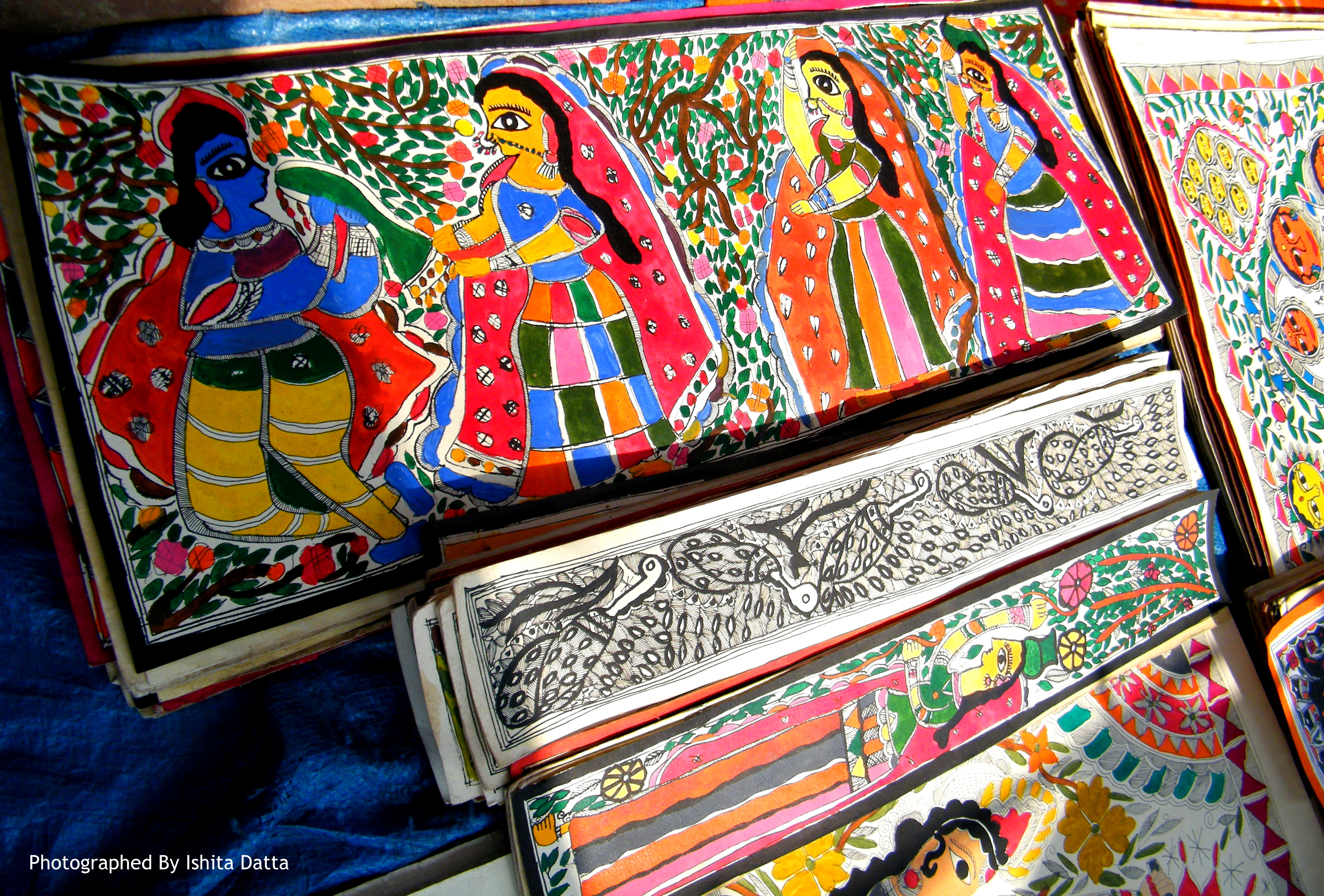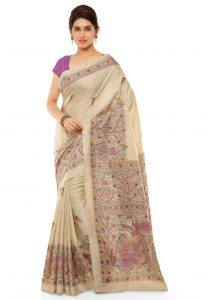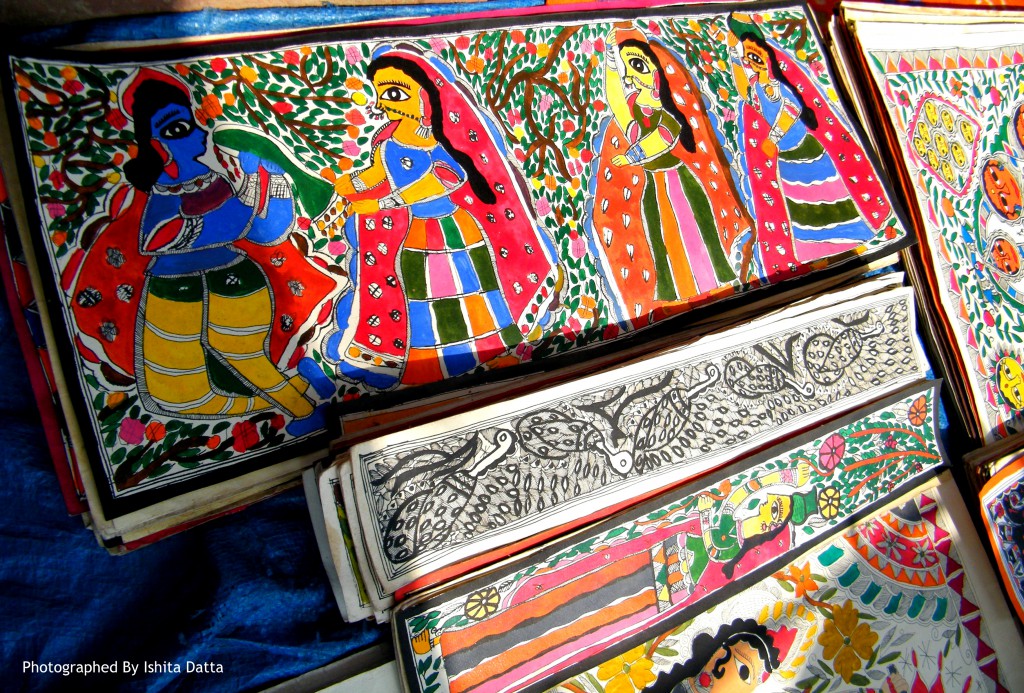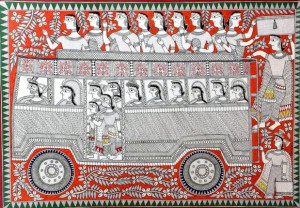
Madhubani or Mithila Painting
Madhubani is a folk painting done by hands, twigs pen nibs and matchsticks with natural colors and dyes. This art has its roots in the Mithila region, hence it is also known as Mithila art or Mithila Painting. Traditionally done by women in the villages of Bihar, the designs and aesthetics of Madhubani paintings have long been an inspiration for many fabric designs.
It is believed that this art form was originated during the times of Ramayana when Raja Janak, father of Sita called artists to capture the wedding of Lord Ram and Sita in the form of Madhubani paintings.
Origin & History
Madhubani carries a rich cultural legacy. Mithila being the birth place of queen Sita, the extraordinary tales of Madhubani art find its ancient ties in the mythical lore of Ramayana, with frequent depictions of her life stories. One can easily identify this rich craft because of its characteristic colorful geometric designs, Madhubani designs essentially depict scenes of royal courtyard, and Indian weddings, marriages and symbols of fertility and prosperity with dominance of motifs like fish, parrot, elephant, turtle, sun, moon, bamboo tree, lotus, etc. To maintain the creativity and precision, Madhubani paintings are made from the powdered rice paste, using fingers, nib-pens, brushes, match sticks and twigs, Dyes obtained from trees, fruits, flowers and spices are used to add colors. Women of Mithila spend dedicated hours every day to create these meticulous designs using two styles of coloring – Bharni and Kachni. The latter is used to outline the designs with fine lines while the Bharni process is used to fill in colors.
The women from this region have been practicing folk arts since the 1800’s. The mothers have been passing their knowledge and teachings to their daughters. Teaching them the artistic patterns and dyes little known to the outside world.
Style
The art of Madhubani has three basic styles with regards to the caste system.
The first one is by the Brahmins. They are regarded as the highest among the three castes. Their paintings have vibrant colors and religious motifs of various gods. Since they has easy access to sacred texts, it helped them portray the mythological and religious motifs with ease.
The second one is by the Kayasthas. They were second to the Brahmins in the hierarchy of caste. Their style of painting symbolized fertility. The style has been practiced the the Aryan invader’s era and included motifs symbolizing procreation. Some common motifs used by them are lotus plant, sacred symbols, fish, tortoises, parrots and birds.
The third one were the Dusadhs. They were a low caste group who were banned from using any religious motif in their art. Their style of painting is also known as Tattoo or Godhana painting. Common motifs of flora and fauna can be seen in their art. With time as the social acceptance widened, they have now started painting motifs of gods. Interestingly, their use of vibrant colors is quite similar to the Brahmin style of painting.
Innovation
Madhubani art celebrates every occasion and festival like wedding, Kali Puja, Durga Puja, Holi, and many more. Conventionally, this art was done to decorate and add colors to homes. But with changing times, it is now even done on clothing, handmade papier-mâché products and wall paintings. Universally known as the women’s art, today the creative world is seeing a gender shift where men are seen adding their artistic touch to this traditional art form. Paper stands, magazine case, games of Ludo, and jewellery boxes made of papier-mâché, book marks are painted with Madhubani designs.
Innovation
Universally known as the women’s art, today the creative world has witnessed a gender shift where men are seen adding their artistic touch to this traditional art form. In modern times, fashion gurus are going back to the rich textile heritage of this art and reviving this art by designing Madhubani sarees, dupattas, and Indo-western dresses.
At numerous fashion weeks, designers have showcased a color-filled collection of Madhubani designs. From sarees, salwar kameez, long skirts and palazzo pants are beautifully designed in Madhubani art.

Printed Pashmina Silk Saree in Beige
Conventionally, this art was done to decorate and add colors to homes. But with changing times, it is now even done on handmade papier-mâché products and wall paintings. Paper stands, magazine case, games of Ludo, and jewelry boxes made of papier-mâché, book marks, and wall hangings are painted with Madhubani designs.
Interesting Facts
Heritage of Madhubani art goes back at least 2,500 years, but it is during the past decade that this folk art has gained much prominence and is being celebrated in the fashion world.
Birth of Lord Krishna, Ram-Sita marriage, Krishna Raas-Leela, Invocation of goddess Durga, Lord Ram’s departure to the forest, are a few mythological events which are finely drawn in the form of Madhubani painting.
In Japan, there is a museum called ‘Mithila Museum’ which has over 850 Madhubani artworks on display. The art of Madhubani is not only famous in India but appreciated by people across the globe!
References
Categories: Motifs & Embroideries


